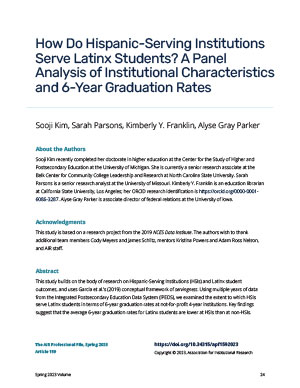The AIR Professional File
Spring 2023, Article 159
How Do Hispanic-Serving Institutions Serve Latinx Students? A Panel Analysis of Institutional Characteristics and 6-Year Graduation Rates
https://doi.org/10.34315/apf1592023Abstract
This study builds on the body of research on Hispanic-Serving Institutions (HSIs) and Latinx student outcomes, and uses Garcia et al.’s (2019) conceptual framework of servingness. Using multiple years of data from the Integrated Postsecondary Education Data System (IPEDS), we examined the extent to which HSIs serve Latinx students in terms of 6-year graduation rates at not-for-profit 4-year institutions. Key findings suggest that the average 6-year graduation rates for Latinx students are lower at HSIs than at non-HSIs.
HSIs and non-HSIs have vastly different institutional characteristics, such as the organizational environment experienced by students and the structural capacity of institutions to respond to students’ needs. Moreover, we find that, at HSIs, neither the share of Latinx students nor the share of Latinx instructional staff promote Latinx students’ 6-year graduation rates. The graduation rates, however, are positively associated with increased institutional spending on research, academic support, and institutional support, which are organizational structures that can respond to students’ needs for academic success, as well as with higher institutional selectivity approximated by an offering of no remedial courses.
Keywords: Hispanic-Serving Institutions; minority-serving institutions; Latinx students; college outcomes; college success
Authors
- Sooji Kim
- Sarah Parsons
- Kimberly Y. Franklin
- Alyse Gray Parker
Acknowledgements
This study is based on a research project from the 2019 NCES Data Institute. The authors wish to thank additional team members Cody Meyers and James Schiltz, mentors Kristina Powers and Adam Ross Nelson, and AIR staff.
Copyright © Association for Institutional Research 2023

